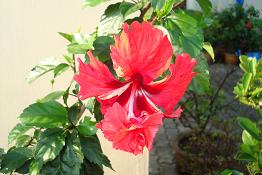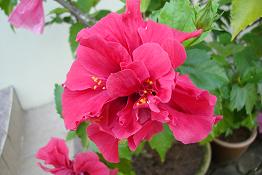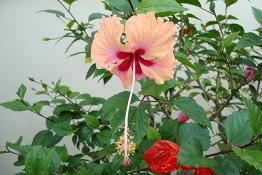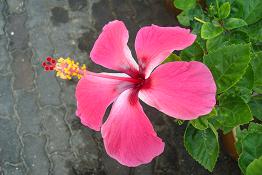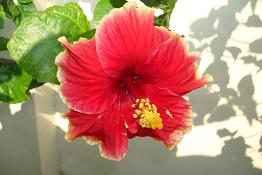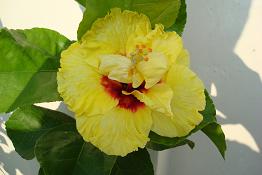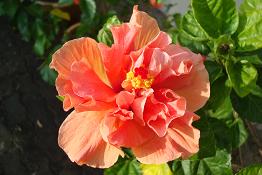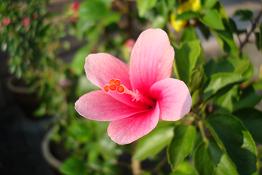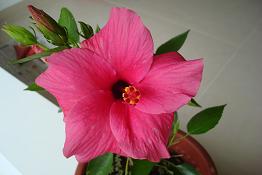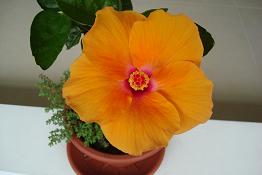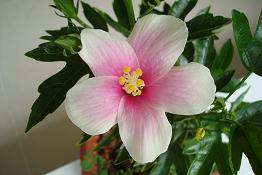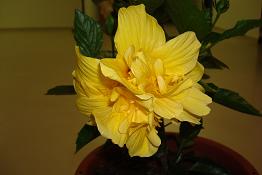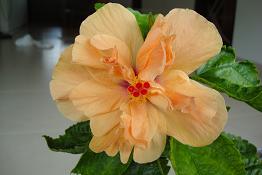The hibiscus plant commonly seen in parks or garden is likely to be Hibiscus rosa-sinensis (Rose of China). It is attractive due to the usually large, trumpet-shaped and colourful flowers. Besides the ones with red flowers, there are plants with flowers of different colour shades or combination of colours. The large petals form the colourful part of the flower. The plant is grown for its ornamental value. The flower usually lasts a day after fully bloom.
The pinkish-white hibiscus flower seen below is from one of my hibiscus plants. I have labelled it to illustrate the different part of a typical
flower. 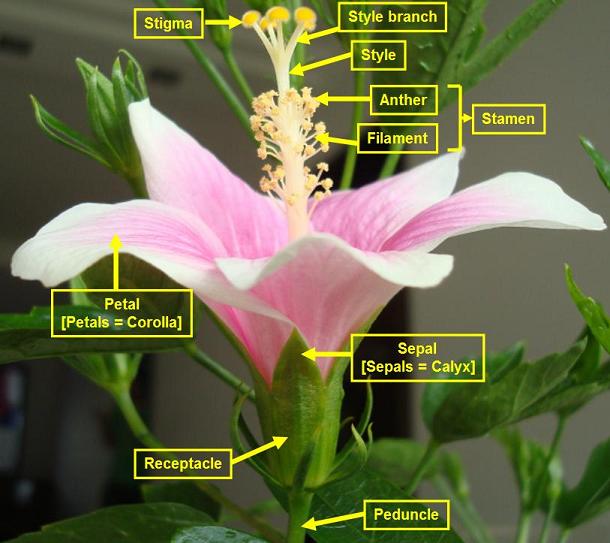 Both male and female organs are found on the same flower.
Both male and female organs are found on the same flower.
The five hairy red spots shown below is a close-up view of the tip or stigma (female part) of the flower. The stigma is located at the end of the style branch.
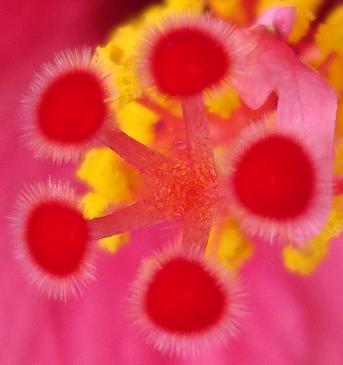
The male part (stamen) of the flower consists of stem-like filaments and each filament ends with the pollen-producing anther. The base of the
filament is attached to a cylinder-like stem, known as a staminal column or stamen tube. Below are the stamens from 3 of my hibiscus plants.
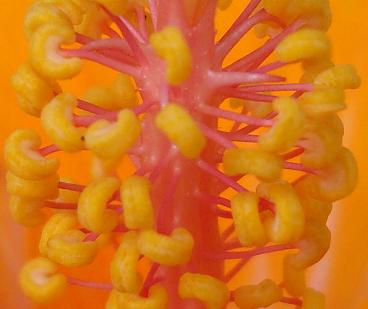
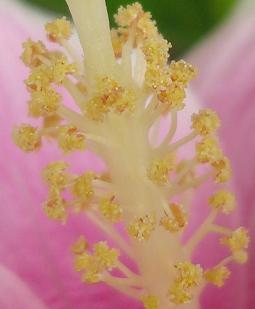
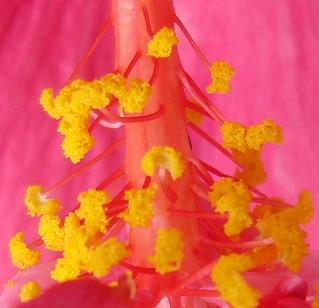
Hibiscus rosa-sinensis has a genetic characteristic known as polyploidy, in which there are more than two sets of chromosomes. Due to this genetic characteristic, the offspring may be quite different from the parent. Plant breeders have used this characteristic to produce a wide variety of hibiscus plants with different flower colours and shapes.
The genetic information that produces stamens is closely related with that which produces petals. This closeness in the genes allows development
of petals from the stamens. It sounds wired but this is a characteristic of hibiscus flower. The yellow "scramble-egg"-like hibiscus flower
below is a result of this phenomenon. For the one with red flower, you can also see some petals forming around the stamen area.
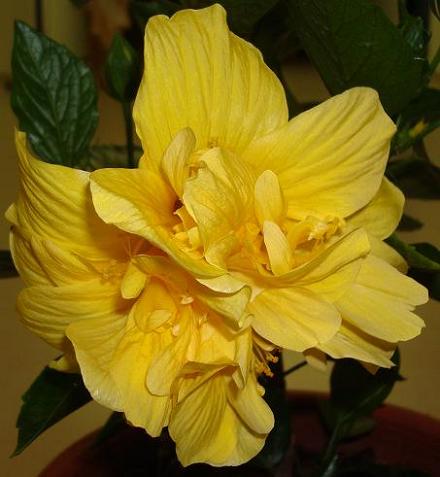
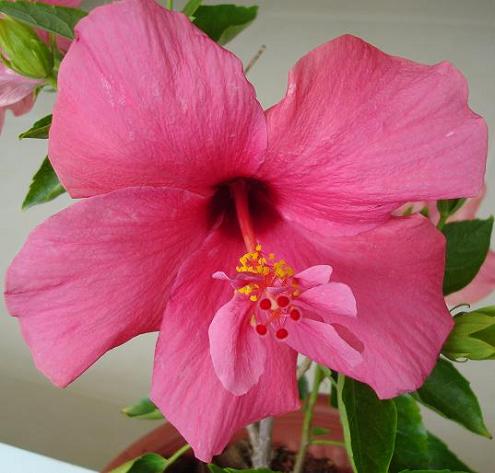
These 9 hibiscus plants were once grown by my father-in-law back in 2009. He was no longer growing them now due to his health condition.
Once upon a time, I had 5 hibiscus plants. They did well in the first few months when I got them. Later, they were invaded by aphids which proved hard to eliminate (see below). As a result, I had lost my initial interest in growing this plant and eventually exit them altogether.
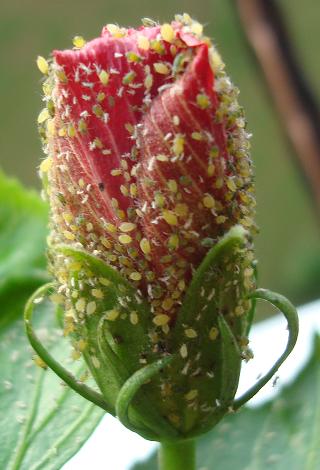 Aphid is one of the plant-juice sucking insect found on hibiscus plant. Once it has
established its colony on a plant, it is difficult to get rid of it even with extreme measure. I had gone through this agony when one-by-one,
all my hibiscus plants got aphids on them.
Aphid is one of the plant-juice sucking insect found on hibiscus plant. Once it has
established its colony on a plant, it is difficult to get rid of it even with extreme measure. I had gone through this agony when one-by-one,
all my hibiscus plants got aphids on them.
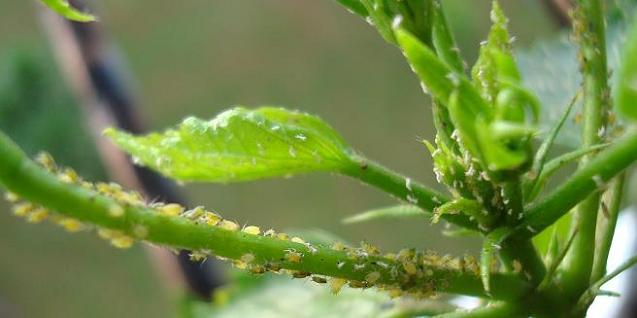
Ants are likely to be one of the culprits that aided in the aphid's invasion. They carried the aphids and position them at strategic locations on
the plant, young leaves and flower buds. Though I heard of ladybird beetles being one of
the predators of aphids, s.jpg) , I could not really figure out how to these
beetles to clear the aphids. I had tried using water spray to contain them but it did not work well. After running out of options, I started
the plants on chemotherapy (chemical spray) but this proved to be a futile effort. Furthermore, the plants did not tolerate chemo well.
, I could not really figure out how to these
beetles to clear the aphids. I had tried using water spray to contain them but it did not work well. After running out of options, I started
the plants on chemotherapy (chemical spray) but this proved to be a futile effort. Furthermore, the plants did not tolerate chemo well.
The white dandruff-like particles on the plant are likely to be their casts or shells. They were shed when the aphids grow out of their existing size. Judging from the amount of "dandruff", one can clearly tell that the colonies are thriving very well ---- in the expense of my poor hibiscus plants. After a few months of battle, I decided that it was game over and I had to move on. This ended my adventure with the hibiscus plants.
Last updated: 18 July 2010
